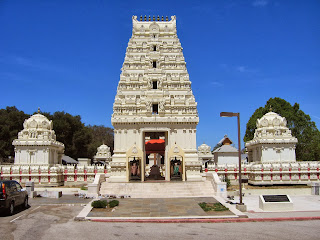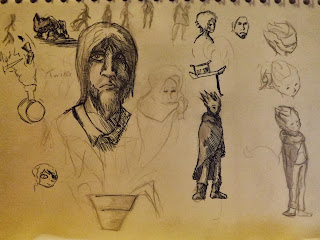People enjoying the festival, throwing the gulal at each other. As you can see, there's a whole spectrum of colours here of reds, blues, yellows, greens and violets. They're all very vibrant.
The wolf mask has nothing to do with the festival itself, it's just someone having a bit of fun and I quite liked how the image looked. It really shows of the relaxed feel of this festival as people dress up in costumes (like this wolf with sunglasses) and really treat it as a bit of fun.
The above images are all from the Holi Festival. The Holi Festival is celebrated on the day after the full moon in early March every year. It originated as a festival to celebrate good harvests and fertility of the land and has now transformed into a symbol of commemoration of a legend from Hindu Mythology. The story centres around an arrogant king who resents his son, Prahlada, for worshipping Lord Vishnu. He attempts to kill his son but fails every time. Eventually, the king's sister Holika, who is said to be immune to burning, sits with the king's son in a huge fire. However, the prince emerges unhurt while Holika is burnt to death. Holi commemorates this event and huge bonfires are burnt on the eve of Holi as its symbolic representation. (source: http://www.indiaexpress.com/rangoli/holi.html 25/10/2013)
Today, Holi is an excuse for Indians to shed inhibitions and caste differences aside for a day of spring fever and fun. Tensions become relaxed, families shake hand and everyone chases each other with brightly coloured powder (known as gulal) and water over each other, all in good fun. Bonfires are lit in the night to clean the air of evil spirits and to symbolise the destruction of Holika (similar to how we set up a bonfire to symbolise the death of Guy Fawkes.)
I really like this festival. The symbolism of it and the bright, vibrant colours that come out of it and what it's used for (breaking up bad relations etc.) The colours are all bright and kind of chalky, in that these are the colorus you find chalks to generally be in. It's the kind of style that we're after and the Holi festival depicts that perfectly.
The above three images I picked out to try and convey the dense and populated place that India is and the kind of atmosphere we're after. You can see all of the people shuffling around the city and how the buildings look like they're piled on top of each other.
This is a Hindu temple. I picked it out to kind of show what kind of designs they have for religious places. Tall towers and intricate stoneworks are a common theme here.
Above is images taking of Indian cities, such as Delhi, as well as religious buildings. I picked these images as they give the kind of dense environment that I mentioned earlier, where it looks as if one house was built on top of another to conserve space. It's brought it all into a kind of hap-hazard design.
The above image is a religious temple in Tibet. It looks like it kind of builds upon itself as it goes up.
Tibet is known for intricate paintings along its interior designs.
The building below seems to crop up a lot when you search for Tibet on Google. It's called the Lhasa Potala Palace. It's built on top of a steep hill and seems to have a very dominating presence in the province. The towering walls with its grand design and ascending stairs really gives it a feeling of importance. Inspiration from this building could be very useful when designing the centre of our city.
Ideas drawn up for the game.
Above is just a very basic idea. Not too pleased with it, so once I've finished I'll try redoing it but with more intricacy and a bigger building. This was kind of my first impression of Tibetan buildings.
Below are just a bunch of random drawings as we were brainstorming different ideas for our game at the beginning. We played with many ideas, such as a floating island.
Teammate blogs:
http://zakfield.blogspot.co.uk/
http://pluckyduckart.blogspot.co.uk/
http://jnestorstudentblog.tumblr.com/

























